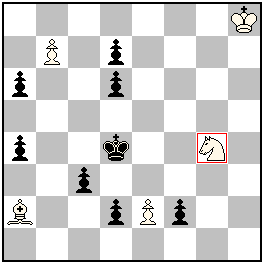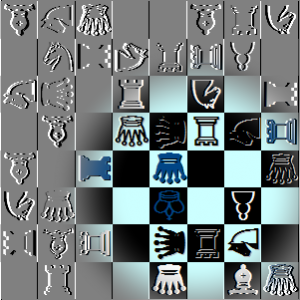|
|
Original Problems (page 93)Original fairy problems published during 2012 will participate in the informal tourney JF-2012. The site is mostly about fairies, but h# and s# are also welcomed for publication! Please send your problems to my e-mail: julia@juliasfairies.com Go to →List of Problems; →Page 92 ; →Page 94 |
No.158 – h#2 by Julia Vysotska – Funny play of 2 promoted pawns, promotions into Chameleons, Anti-Andernach effects.
I like this one myself, although speaking about themes there’s nothing much to write about. 🙂 I regret a little that can’t take off 1 piece to get a Meredith and also that static Sg4 (or theoretically any other piece) has to be a Chameleon piece with the only purpose – to allow a promotion into Chameleon. (JV)
Definitions:
Chameleon: On completing a move, a Chameleon (from classical standard type) changes into another piece, in the sequence Q-S-B-R-Q… Promotion may be to a chameleon at any stage in the cycle.
Anti-Andernach Chess: a unit (not King) changes color after its moves unless that move is a capture. (Or: a unit (King excluded) changes color on completion of a non-capturing move.)
You can сlick on “Solutions” to show or hide the solutions!
|
No.158 Julia Vysotska
Latvia
original-25.10.2012
 h#2 2 solutions (5+8)
Anti-Andernach
Сhameleon Sg4 Solutions: (click to show/hide)
|
The diagrams are made on WinChloe and its Echecs font is used for Logo design



Nice matching promotions and by black and white ! Only weakness: the original chameleon g4 does not move !
Very nice idea. For active play of original chameleon, extra move is needed and that’s probably not easy. Meredith might be achieved. For instance:
White chameleon Re7
White Kh8 Pd7 Pe2
Black Pa4 Kd4 Pc3 Pd2 Pf2
Oh, wow! 9 pieces instead of my 13 ! And I thought, I’m becoming better in technique! Very slowly becoming it seems.. 🙂
Nikola’s version, Meredith:
[img]http://www.ankona.ch/diagrams/100023.png[/img]
h#2; antiandernach; 4+5
1.d2-d1=wcS d7-d8=bcS 2.cSd8-f7=wcB cSd1*f2=cB #
1.d2-d1=wcB d7-d8=bcB 2.cBd8-a5=wcR cBd1*a4=cR #
I’m thinking why haven’t I tried something like this? Definitely, I’d be afraid to use wR because of more possible cooks. But I see here’s the opposite situation – less of cooks, and white chameleons guard 2 squares in each solution. Fine!
What’s about using my static wS-chameleon or wR-chameleon in Nikola’s version – yes, I don’t like it myself, same as Seetharaman, but this is the only option here to allow a promotion into Chameleon-piece!
Very economical reconstruction ! Nice position with only 9 ! Welldone !!
A nice problem with matched promotions. When I saw it yesterday I was pretty sure that the position can be improved, but after come back at home to try, I saw that Nikola was ready with it… Well done! In my opinion using of static chameleon piece is a weakness, so I think it’s better to use a regular pieces diagram, but the fairy condition “Chameleon chess” to be included.
By the way the idea can be realised even in miniature form:
white: Ka8, Qc1, Pf7
black: Kb4, Pb3, d2, f2
H#2 b)Pd2-c4 (3+4)
Anti-Andernach, Chameleon Chess
Or can be realised in white minimal and Pawns only position:
white: Kd4, Pd7
black: Kb4, Pa3, b3, b6, d2, f2
H#2 b)Pd2-c4 (2+6)
Anti-Andernach, Chameleon Chess
Chameleon Chess is a nice suggestion Diyan. It can be done without twinning, if that is preferable (though with one pawn more !).
W: Kf4 Pd7 — B: Kd4 Ps f7, b6, a4, c3, d3, d3 & f2.
Actually two pawns more 🙂
W: Kf4 Pd7 — B: Kd4 Ps f7, b6, a4, c3, d3, d2 & f2.
Well, Diyan, yes, but for me the most complicated and also interesting thing was to get that promotion into Chameleon exactly! Maybe it couldn’t be called a content, but still it was like a zest for me in this problem. Am I wrong thinking so?
Thank you!
Yes, there are many ways to improve this interesting problem. Nikola’s position is a step forward in technical attitude. But possible is, for example, a position with 8 pieces only: [/img]
[/img]
[img
1.d1=wCB h8=bCB 2.CBe5=wCR CBxa4 =wCR#
1.d1=wCS h8=bCS 2.CSf7=wCB CBxf2=CB#
A miniature form is possible also, using the twins a) Position – without Pa4; b) Position – Pf2-a4.
About use of a static Chameleon here – I don’t think that it is a big weekness, through this piece is only a technical component here. Chameleon in such positions, as all other fairy pieces, legalizes the promotion into Chameleon pieces. Therefore, this piece is needed here as thematic factor. On a shortest distance it is practically impossible to use it in thematic role.
About use of a new condition Chameleon Chess
It is a not good solution here, because this new condition is rather restrictive – in Chameleon Chess we cannot promote pieces into other figures – here possible are only Chameleon-promotions. With such powerful restriction it is possible to get a better positions, but de facto the play here is different and more primitive. It is very important to remind that in Julia`s problem and in Predrag`s version not only chameleon-promotions are possible but also orthodox promotions! Adding the Chameleon Chess here, we simplify the initial theme to a primitive idea which is very easy to realize.
A combination between Anti-Andernach and Chameleon Chess is good and fruitful but not in such form. Because the Chameleon Chess is a rather restrictive condition which is easy to realize, a recommended thematic with this condition is different tasks with promotions a la AUW, Babson etc.
I am completely agree with Mr. Petkov and Julia that without Chameleon Chess there are options to be promoted regular pieces also, but one of the reason to my suggestion was that with this condition we can present the idea with Pawns only position. Personally in this case I prefere it because the choice between Chameleon and Regular piece promotion here do not add nothing in this composition. But of course if this choice was thematic the better will be to be used Chameleon piece (for example as in the excellent problem n.10 on the following link: http://kobulchess.com/en/problems/chameleon-50-jt-2012-originals/128-chameleon-jt-9-10.html )
After explanations by Mr. Petkov, passive original chameleon does not seem so bad. I posted the quick example with wcR mostly because it looked promising for extension to h#2,5. I had no time in the afternoon and now I can not make a satisfying progress but it does not look completely impossible.
The following zero-position shows some possibilities:
Stipulation H#3
Condition AntiAndernachChess
Pieces
White chameleon Bd8
White Kh8 Pd7 Pb2 Pe2
Black Pc7 Pa5 Pa4 Kd4 Pe3 Pd2 Pf2
WhiteToPlay
Zero Move e3 e7
Twin Remove b2
a) bPe3–>e7
1…cBxe7=cR 2.d1=wcS d8=bcS 3.cSf7=wcB cSxf2=cB#
b) -wPb2
1…cBxc7=cR 2.d1=wcB d8=bcB 3.cBg5=wcR cBxa4=cR#
By the way, n.10 at Kobulchess is indeed amazing! A question which is not important for the quality of that problem but is important for my understanding: Is the mentioned Bivalve-theme present in the solutions or only in tries?
If only in tries, the solutions would be something like Bivalve avoidance.
You are right Nikola. The bivalve effect is in tries only in problem N.10 at Kobulchess. In the solution it is line opening by the black knight with dual avoidance.(and mutual battery creation of course).
Oh, while I was sleeping everything is already explained about my No.10 at KobulChess.com!
Nikola’s zero-position for those, who likes to see the diagram:
[img]http://www.ankona.ch/diagrams/100025.png[/img]
h#2.5; zeroposition; a) bPe3->e7, b) -wPb2; (5+7)
antiandernach
a) bPe3–>e7
1…cBd8*e7=cR 2.d2-d1=wcS d7-d8=bcS 3.cSd8-f7=wcB cSd1*f2=cB #
b) -wPb2
1…cBd8*c7=cR 2.d2-d1=wcB d7-d8=bcB 3.cBd8-g5=wcR cBd1*a4=cR #
I think about it myself too.
Also after Mr.Petkov’s comment I guess we can try to use AntiAndernach & ChameleonChess conditions and 4 promotions (4 solutions). I’m not sure if I can do it, and your versions are very welcome!
Zero-position may serve to illustrate the idea but regular twinning will serve better:
Stipulation H#2,5
Condition AntiAndernachChess
White chameleon Bc8
White Kh8 Pc7 Pb2
Black Pb6 Pd6 Kc4 Pf4 Pb3 Ph3 Pc2 Pe2
b) bPd6–>d7
a) 1…cBxh3=cR 2.c1=wcB c8=bcB 3.cBf5=wcR cBxf4=cR#
b) 1…cBxd7=cR 2.c1=wcS c8=bcS 3.cSe7=wcB cSxe2=cB#
Now the original Chameleon plays in the solutions and is not so desperately closed on c8 in the twin. Still, the superfluous wPb2&bPb3 in a) suggest that improvements might be possible.
see–> http://pdb.dieschwalbe.de/search.jsp?expression=PROBID=%27P1307705%27